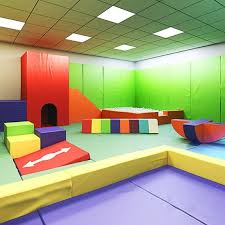
Unleashing Fun and Learning Through Indoor Play Adventures
The Benefits of Indoor Play for Children
Indoor play is not just a way to keep children entertained; it also offers numerous benefits for their development and well-being. In today’s fast-paced world, where screen time often dominates leisure activities, indoor play provides a valuable opportunity for children to engage in active, imaginative, and social play.
Physical Development
Indoor play spaces are designed to encourage physical activity, which is crucial for children’s overall health and development. Climbing structures, slides, ball pits, and other play equipment help children build strength, coordination, and balance. Regular physical activity also contributes to better sleep patterns and improved mood.
Cognitive Skills
Indoor play stimulates children’s cognitive skills by providing opportunities for problem-solving, decision-making, and creative thinking. Through imaginative play scenarios and interactive games, children can enhance their language skills, memory retention, and spatial awareness.
Social Interaction
Playing indoors with other children promotes social interaction and communication skills. Children learn how to take turns, share resources, negotiate conflicts, and work collaboratively towards common goals. These experiences lay the foundation for developing empathy, teamwork, and relationship-building skills.
Safe Environment
Indoor play areas offer a controlled environment where children can explore and experiment safely. Parents can relax knowing that their children are playing in a secure space supervised by trained staff. This sense of security allows children to push their boundaries and try new activities without fear of getting hurt.
Creative Expression
Indoor play encourages creative expression through arts and crafts activities, storytelling sessions, role-playing scenarios, and more. Children have the freedom to express themselves in various ways, fostering their imagination and self-confidence. These creative outlets help children develop a sense of identity and explore their interests.
Conclusion
Indoor play is an essential component of every child’s development journey. By providing a stimulating environment that supports physical activity, cognitive growth, social interaction, safety assurance, and creative expression, indoor play spaces contribute significantly to children’s overall well-being. So next time you’re looking for a fun and enriching experience for your child, consider the benefits of indoor play!
Eight Key Benefits of Indoor Play for Children’s Development and Well-being
- Promotes physical activity and exercise
- Enhances cognitive skills through interactive play
- Encourages social interaction with other children
- Provides a safe environment for supervised play
- Fosters creativity and imaginative expression
- Offers a variety of activities to keep children engaged
- Helps develop coordination, balance, and motor skills
- Allows children to explore and learn in a controlled setting
Seven Drawbacks of Indoor Play Centres: From Limited Space to Health Concerns
- Limited space for active play compared to outdoor environments.
- Potential for overcrowding during peak times, leading to wait times for popular attractions.
- Risk of spreading germs and illnesses due to close contact with other children in enclosed spaces.
- Indoor play equipment may not always be well-maintained, posing safety hazards.
- Some indoor play areas can be noisy and chaotic, which may overwhelm sensitive children.
- Entrance fees or admission costs can make frequent visits to indoor play centres expensive for families.
- Children may become overly reliant on structured indoor activities, limiting their creativity and independence.
Promotes physical activity and exercise
Indoor play promotes physical activity and exercise by providing children with a safe and engaging environment to move, climb, jump, and explore. With a variety of play equipment and structures designed to challenge their motor skills, children can develop strength, coordination, and balance while having fun. This active play not only contributes to their physical health but also helps them burn off energy, improve their mood, and establish healthy habits from a young age.
Enhances cognitive skills through interactive play
Indoor play offers a valuable opportunity for children to enhance their cognitive skills through interactive play. Engaging in imaginative scenarios, problem-solving games, and creative activities stimulates children’s thinking processes, memory retention, and spatial awareness. By encouraging children to explore, experiment, and make decisions in a playful setting, indoor play fosters critical thinking skills and helps them develop a deeper understanding of the world around them. This type of interactive play not only entertains but also educates, laying the foundation for lifelong learning and cognitive development.
Encourages social interaction with other children
Encouraging social interaction with other children is a key benefit of indoor play. By engaging in group activities and games, children learn valuable social skills such as communication, cooperation, and empathy. Interacting with peers in a safe and supervised environment helps children build friendships, develop teamwork abilities, and navigate social dynamics effectively. Indoor play fosters a sense of belonging and community among children, promoting positive relationships that contribute to their overall social development.
Provides a safe environment for supervised play
Indoor play offers a safe environment for supervised play, ensuring that children can explore and have fun under the watchful eye of trained staff. Parents can have peace of mind knowing that their children are playing in a secure space where potential hazards are minimized. This controlled setting allows children to engage in various activities, try new challenges, and interact with others while being guided and supported by attentive caregivers. The safety assurance provided by indoor play spaces enables children to enjoy their playtime to the fullest without compromising on their well-being.
Fosters creativity and imaginative expression
Indoor play fosters creativity and imaginative expression in children by providing them with a space where they can explore, invent, and role-play freely. Through activities such as arts and crafts, storytelling, and pretend play, children can unleash their creativity, develop problem-solving skills, and express themselves in unique ways. Indoor play environments stimulate children’s imaginations, encouraging them to think outside the box and create their own narratives, leading to a deeper sense of self-discovery and confidence in their abilities.
Offers a variety of activities to keep children engaged
Indoor play offers a variety of activities to keep children engaged, ensuring that there is always something new and exciting for them to explore. From climbing structures and imaginative play areas to arts and crafts stations and interactive games, indoor play spaces cater to a range of interests and preferences. This diversity of activities not only keeps children entertained but also encourages them to try new things, develop different skills, and stay actively engaged in stimulating play experiences.
Helps develop coordination, balance, and motor skills
Indoor play is a fantastic way for children to enhance their coordination, balance, and motor skills in a safe and engaging environment. By navigating through climbing structures, balancing on beams, and moving through obstacle courses, children can improve their physical abilities while having fun. These activities not only strengthen their muscles but also help them develop spatial awareness, agility, and fine motor control. Indoor play provides the perfect setting for children to hone these essential skills that are crucial for their overall physical development.
Allows children to explore and learn in a controlled setting
Indoor play provides children with the opportunity to explore and learn in a controlled setting, ensuring their safety while encouraging curiosity and discovery. In this environment, children can engage with various activities and play equipment designed to stimulate their senses and promote learning through hands-on experiences. By offering a structured yet dynamic space for exploration, indoor play allows children to develop new skills, expand their knowledge, and build confidence in a secure and supportive setting.
Limited space for active play compared to outdoor environments.
One significant drawback of indoor play is the limited space available for active play in comparison to the vast outdoor environments. While indoor play areas offer a controlled and safe setting, they often lack the expansive outdoor spaces that allow children to run, jump, and explore freely. The confined nature of indoor play can restrict children’s physical movement and limit their opportunities for large-scale, energetic activities. This limitation may hinder the development of gross motor skills and deprive children of the sensory stimulation that comes from interacting with nature and open spaces.
Potential for overcrowding during peak times, leading to wait times for popular attractions.
One drawback of indoor play centres is the potential for overcrowding during peak times, which can result in long wait times for popular attractions. The high demand for certain activities or play areas may lead to queues and limited access for children, causing frustration and impeding their overall experience. Parents and caregivers may also find it challenging to navigate crowded spaces and ensure the safety of their children in such busy environments. It is important for indoor play centres to manage crowd control effectively during peak hours to maintain a positive and enjoyable experience for all visitors.
Risk of spreading germs and illnesses due to close contact with other children in enclosed spaces.
One significant con of indoor play is the increased risk of spreading germs and illnesses due to close contact with other children in enclosed spaces. In bustling play areas, where children interact closely and share play equipment, the transmission of viruses and bacteria can occur more easily. Despite efforts to maintain cleanliness and hygiene standards, the nature of indoor play environments can make it challenging to prevent the spread of germs effectively. Parents and caregivers need to be vigilant about their children’s health and take necessary precautions to minimise the risk of infections in such settings.
Indoor play equipment may not always be well-maintained, posing safety hazards.
One significant drawback of indoor play is the potential lack of proper maintenance of play equipment, which can pose safety hazards for children. In some instances, worn-out or damaged equipment may not be promptly repaired or replaced, increasing the risk of accidents and injuries. Parents and caregivers must remain vigilant and ensure that indoor play spaces adhere to strict safety standards to protect children from harm. Regular inspections and maintenance schedules are essential to address any potential risks and maintain a safe environment for all young visitors.
Some indoor play areas can be noisy and chaotic, which may overwhelm sensitive children.
Some indoor play areas can be noisy and chaotic, creating an environment that may overwhelm sensitive children. The combination of loud sounds, bright lights, and crowded spaces can be overstimulating for some children, leading to feelings of discomfort and anxiety. It is important for parents and caregivers to be mindful of their child’s sensory sensitivities and to choose indoor play spaces that offer quieter, calmer environments to ensure a positive play experience for all children.
Entrance fees or admission costs can make frequent visits to indoor play centres expensive for families.
Entrance fees or admission costs at indoor play centres can present a significant financial challenge for families, making frequent visits a costly affair. The expenses associated with accessing these facilities can add up quickly, especially for families with multiple children. This financial barrier may limit the frequency of visits, preventing some children from fully benefiting from the enriching experiences and developmental opportunities that indoor play centres offer. As a result, families may need to carefully budget and plan their visits, potentially missing out on the regular engagement that could further enhance their children’s growth and enjoyment.
Children may become overly reliant on structured indoor activities, limiting their creativity and independence.
One downside of indoor play is that children may become overly reliant on structured activities, which can potentially hinder their creativity and independence. When children are constantly engaged in pre-planned indoor activities, they may struggle to think outside the box and explore their own interests freely. This reliance on structured play can limit their ability to problem-solve independently and stifle their creativity as they become accustomed to following set rules and guidelines. Encouraging a balance between structured indoor play and unstructured, imaginative play can help children develop a sense of autonomy and foster their creativity in a more organic way.



